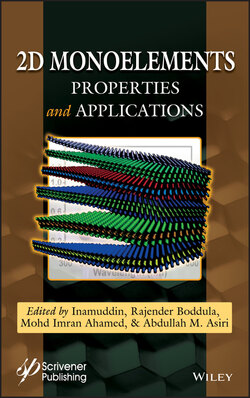Читать книгу 2D Monoelements - Группа авторов - Страница 53
2.4.4 Energy Storage
ОглавлениеOn the strength of high theoretical capacity of 660 mAh g−1, increased active sites, and fast ion diffusion, few-layer antimonene is considered to be a promising electrode material in the energy storage applications, such as sodium-ion batteries (SIBs), lithium-ion batteries (LIBs), and supercapacitors [56–59].
Gu et al. obtained free-standing metallic Sb nanosheets via the LPE method, then fabricated SbNS-G hybrid films with tunable densities, which were subsequently applied to the SIBs [56]. The volumetric capacity of SbNS-G film (1.6 mg cm−2) reached to 1,226 mAh cm−3 in the initial cycle (Figure 2.10a), which was higher than the value of previously reported Sb/C nanocomposites (100–300 mAh cm−3) and graphene film (80 mAh cm−3). Furthermore, SbNS-G film also exhibited a high-rate capacity with both charge and discharge volumetric capacity of 216 mAh cm−3 at a current density of 4.0 mA cm−2 (Figure 2.10b), this result was superior to that of graphene film (13 mAh cm−3). SbNS-G film showed simultaneously a good cycle performance for sodium (Na) storage, where the capacity was still stabilized at 110 mAh cm−3 after 100 cycles at high current density (4.0 mA cm−2). Afterwards, Tian et al. studied the Na storage performance and mechanism of 2D FLA from experiments to theoretical calculations [57]. The FLA electrode delivered a charging capacity of 642 mAh g−1 at a current density of 0.1 C and a rate capacity of 429 mAh g−1 at 5 C, as well as a stable capacity of 620 mAh g−1 at 0.5 C after long-term charging/discharging cycles, which meant the utilization ratio of Sb atoms was as high as 93.9 % (Figures 2.10c, d). For the Na storage mechanism, they thought that FLA experienced a sodiation/desodiation process, where Na first reacted with Sb to form crystalline NaSb intermediate phase then to crystalline Na3Sb in the sodiation process, conversely during the desodiation process, Na3Sb first transformed to NaSb then to Sb with a small number of NaSb. This reversible crystalline-phase evolution was also accompanied by anisotropic volume expansion to achieve structural stability and electrochemical redox kinetics. In addition, FLA also exhibited high-rate lithium (Li) storage capabilities, even without the help of additives [58]. As shown in Figure 2.10e, the stable capacity of FLA after 100 cycles at 0.5 C was 584.1 mAh g−1 with CE of ~100%, which was higher than that of Sb nanoparticles (NPs) (552.3 mAh g−1). FLA displayed a rate capacity of 488 mAh g−1 at 5 C, corresponding to 74% capacity retention of the value at 0.1 C, while the rate capacity of Sb NPs was 443 mAh g−1 at 5 C, and this value was only 67% of the initial capacity at 0.1 C (Figure 2.10f). The higher rate performance of FLA than Sb NPs was attributed to the preferential Li ion dispersion along in-plane channel in FLA.
Figure 2.10 (a) The first and two charge/discharge cycles of the SbNS-G film at a current density of 0.1 mA cm−2. (b) Rate capacities of SbNS-G films with different mass loading (1.6 to 3.2 mg cm−2) and graphene film measured at various current densities (0.2 to 4.0 mA cm−2). (c) Rate performances of FLA electrode. (d) Long-term charging/discharging cycles and Coulombic efficiency (CE) of FLA and bulk Sb at 0.5 C. (e) Cycling performances of bulk Sb, FLA and Sb NPs. (f) Rate capacities of FLA and Sb NPs. (g) Specific capacitance of FLA-modified SPE with different amounts of FLA. (h) Capacitance retention ratio versus cycle number of FLA-modified SPE. (a, b) Reproduced with permission [56]. Copyright 2017, Wiley-VCH. (c, d) Reproduced with permission [57]. Copyright 2018, American Chemical Society. (e, f) Reproduced with permission [58]. Copyright 2019, The Royal Society of Chemistry. (g, h) Reproduced with permission [59]. Copyright 2018, Wiley-VCH.
Apart from the applications in Na/Li ion batteries, FLA can also be used as an electrode material in supercapacitors [59]. Compared to the bare screen-printed electrode (SPE), FLA-modified SPE showed improved energy storage capabilities. The specific capacitance was 1,578 F g−1 at a current of 14 A g−1, and it retained 63%–65% of the initial capacitance value over 10,000 galvanostatic cycles (Figures 2.10g, h). Moreover, FLA-modified SPE demonstrated a low energy density of 20 mW h kg−1 and a high power density of 4.8 kW kg−1.
